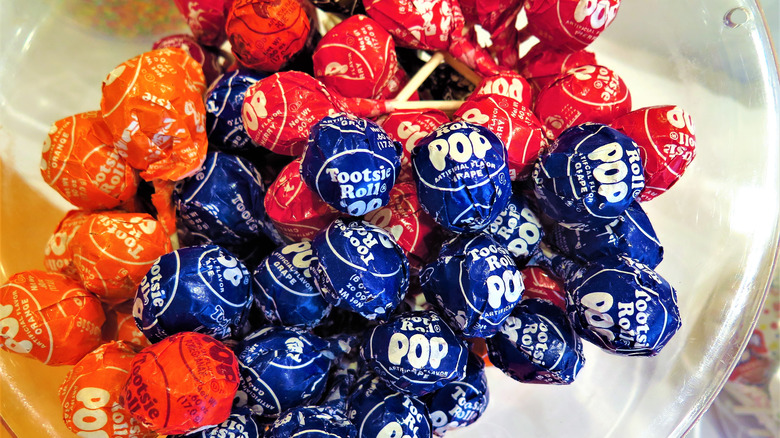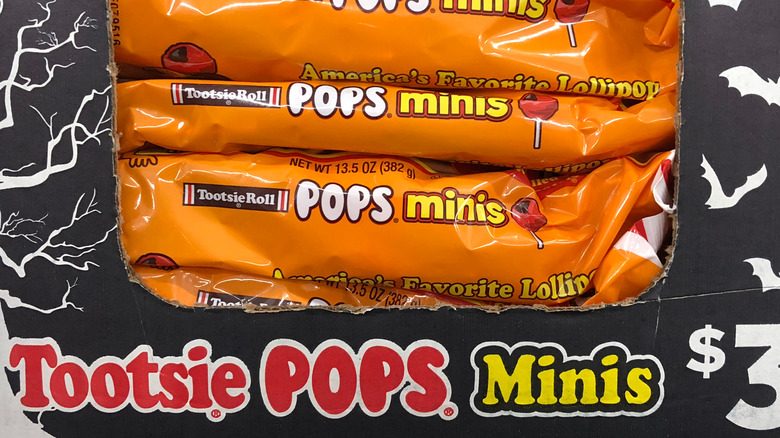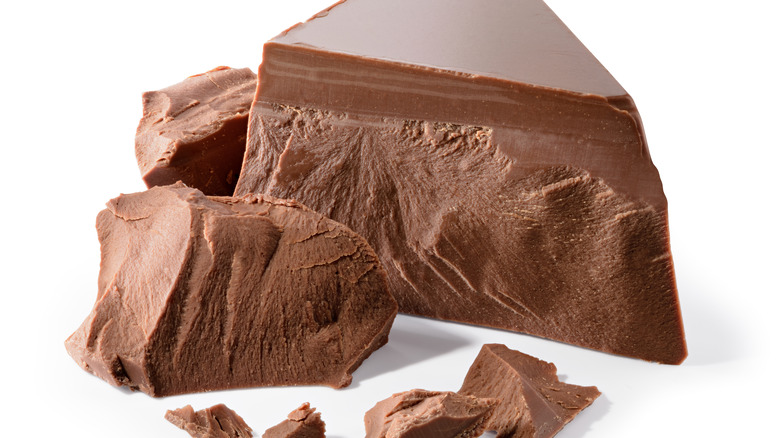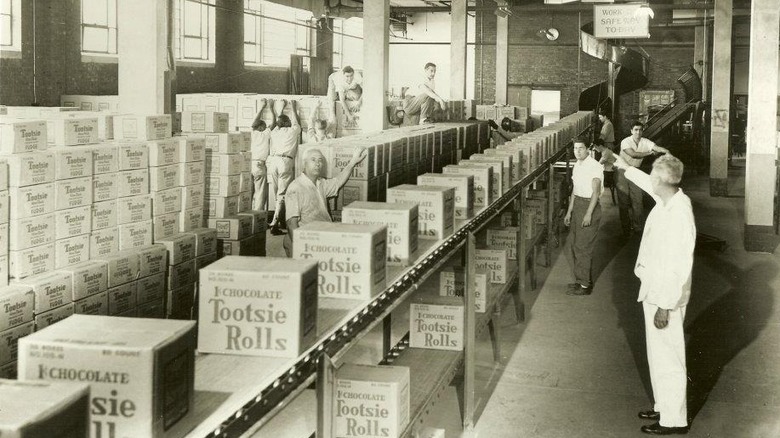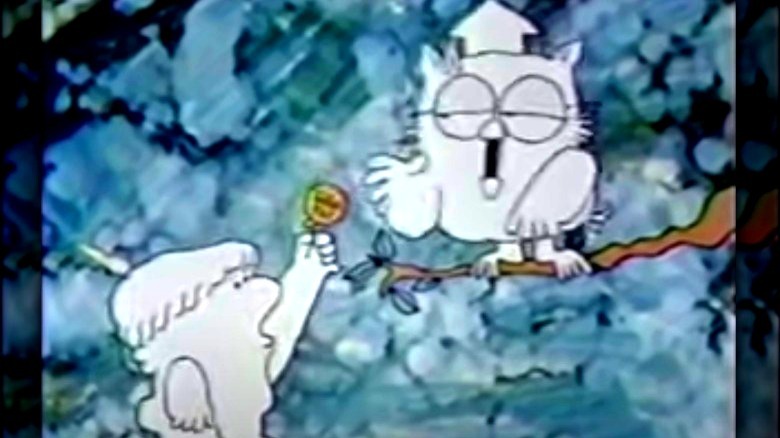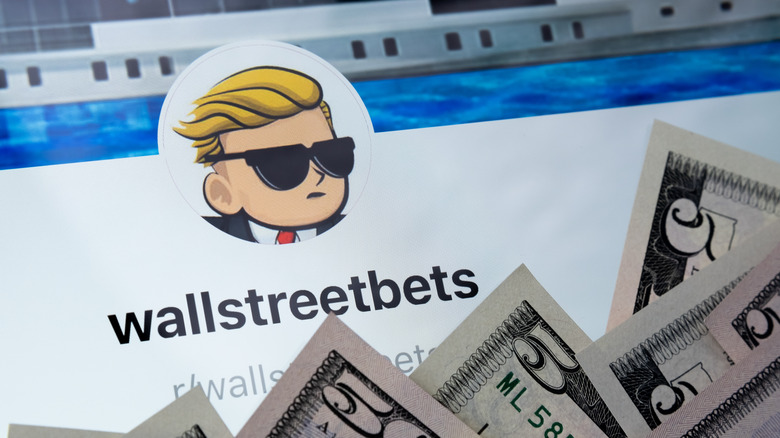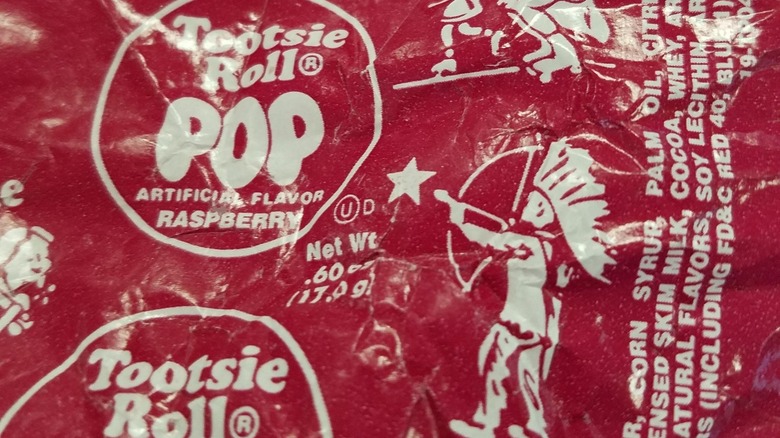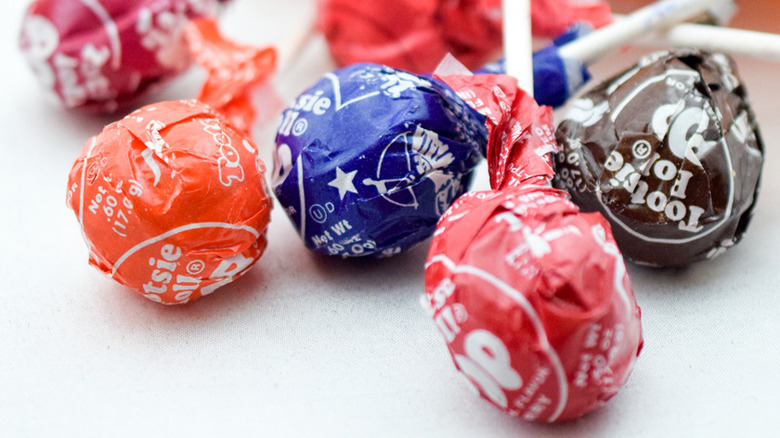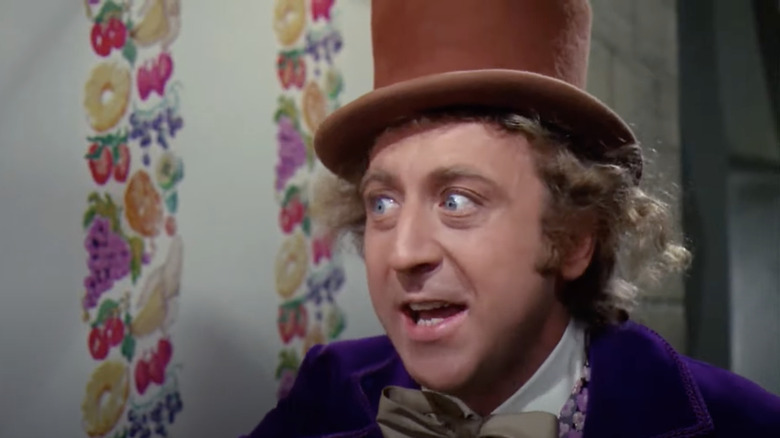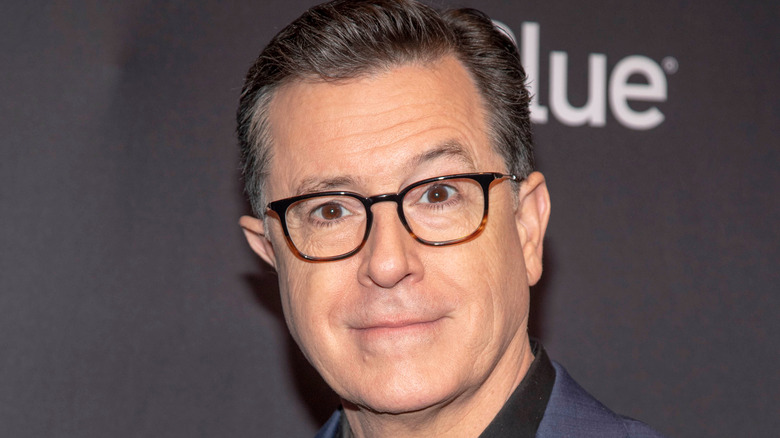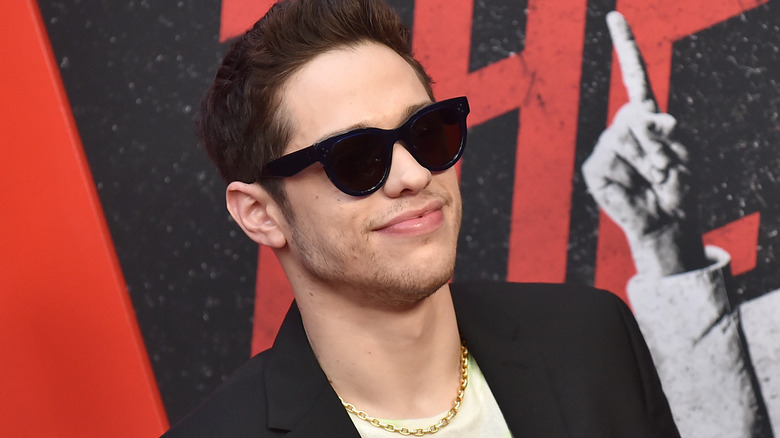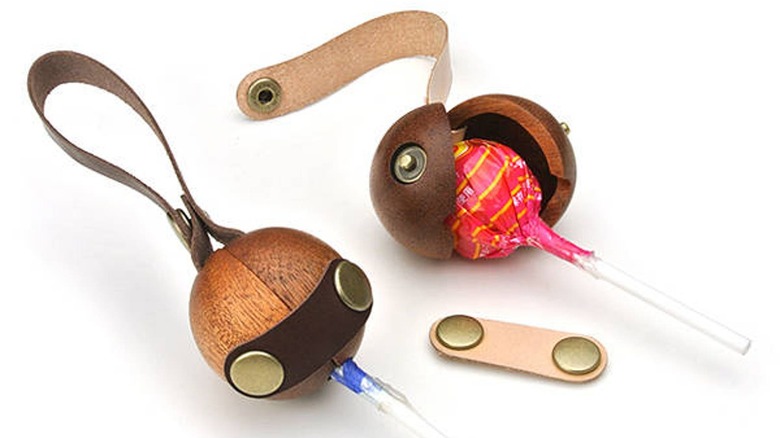The Untold Truth Of Tootsie Pops
Whether you love it or hate it, there's no denying that the Tootsie Pop, with its hard shell coating and chewy chocolate interior, is a classic American candy. It's slightly ironic that Tootsie Pops were partly born out of the imagination of the Austrian immigrant Leo Hirshfield, who invented Tootsie Roll Industries' signature chocolate nougat in 1896 in Brooklyn, New York (via Snack History). But Tootsie Pops are also so much more than Toostie Rolls' younger siblings.
Invented in 1931, their popularity soared during the Great Depression because they were tasty and inexpensive. By 1970, the candy product was responsible for inspiring one of the most iconic TV commercials ever. Over half a century later, few are likely to forget the infamous question: How many licks does it take to get to the center of a Tootsie Pop? That ad spot has certainly been a driving factor in the lollipops' enduring popularity. As it turns out, there's more to Tootsie Pops than their wise-cracking owl mascot and supposedly redeemable candy wrappers. Here's everything you need to know about the world-famous lollipop candy.
Its inventor's daughter inspired the Tootsie Pop
The iconic hard-shell lollipop and its chewy center first came onto the scene in 1931, according to the company website. It was invented by Luke Weisgram, an employee at the then-named Sweets Company of America. He and his colleagues were asked to pitch ideas for a new candy at a meeting. The idea "popped" into his head because he had licked his daughter's lollipop while chewing a chocolate Tootsie Roll at the same time. He found the combined flavors were a tasty surprise. The board of the company liked Weisgram's candy idea so much they agreed to put it into production, and so the Tootsie Pop was born and immediately became a beloved American classic. The company where Weisgram worked would later change its name to Tootsie Roll Industries (via Snack History).
Weisgram wasn't the only company worker to find inspiration in his daughter. Tootsie Roll inventor Leo Hirshfield opened a candy business in 1896 in Brooklyn, New York, and "Tootsie" was Hirshfield's nickname for his 5-year-old-daughter Clara. Some historians believe the wholesome-sounding origin story might be little more than clever marketing. According to a Time report, a professor at Rutgers University posited that Hirshfield had been an employee at candymaker Stern & Staalberg and that the company fabricated the story about Tootsie Roll's humble origins. Stern & Staalberg started marketing the candy in 1909, a year after Hirshfield was awarded a patent for Tootsie Rolls.
The first Tootsie Pop flavor was chocolate
It probably shouldn't come as a surprise that the first flavor of Tootsie Pop to be made was chocolate, since the Tootsie Roll hidden in the center of each lollipop was also chocolate-flavored and already a popular treat among American consumers (via Snack History). Double chocolate turned out to be double tasty. But eventually, the candy maker debuted other flavors, too, most notably cherry, orange, grape, and raspberry, according to the company website. Today, Tootsie Roll Industries continues to come out with new flavors. The candy company has since released seasonal flavors as well, such as candy cane and pumpkin-flavored Tootsie Pops.
In addition to new flavors, different versions of Tootsie Pops have been released over the years like Tootsie Pop Miniatures, smaller versions of the classic lollipop. The miniatures typically come in a bag of assorted flavors. Fans can also enjoy Tootsie Pop Drops — lollipops minus the sticks, so you can pop them into your mouth.
The Great Depression launched Tootsie Pops' popularity
Tootsie Pops debuted just one year after the start of the Great Depression, and according to Smithsonian Magazine, they were instantly a big hit because they were cheap yet tasty at a time when people were in dire financial straits. Everyday Americans weren't the only ones who hit hard times during this era. The Sweets Company of America, Tootsie Pops' manufacturer, fell on hard times in 1932 (via We Texas). Bernard D. Rubin of Joseph Rubin & Sons — the confectionary's box supplier — took over as president. This turned out to be a wise move. Over the years, Rubin increased revenue and strengthened the company's bottom line.
The onset of World War II only accelerated the candy company's popularity. Per Popular Science, the Second World War proved to be a critical moment in history in terms of cementing processed foods as part of the ordinary American diet, including Tootsie Roll chocolate because of its long shelf life and ability to withstand hot weather. The company's website says that throughout the war, Tootsie Rolls were included as part of soldiers' rations. In fact, one pilot whose plane crash-landed in the Sahara lived on Tootsie Rolls for three days (via Google Books). The candy company's patriotic history cemented its status as one of America's favorite candy makers.
No one knows how many licks it actually takes to get to the center of a Tootsie Pop
No report on Tootsie Pops would be complete without an attempt answer to the infamous question behind the lollipop brand: "How many licks does it take to get to the center of a Tootsie Pop?" The question was first posed in a commercial that debuted in 1970. In it, a young cartoon boy presents that very question to various talking animals. One of these animals includes the brand's mascot, Mr. Owl, who facetiously answers the boy's riddle by licking the Tootsie Pop exactly three times before biting into its center.
In a recent study, researchers from New York University and Florida State University attempted to answer the question and concluded that it takes about 1,000 licks to the lollipop's center based on a theory about how saliva dissolves materials like the hard shell coating of a Tootsie Pop (via Time). Researchers at Perdue University were so determined to answer the question that they invented a licking machine. Yes, you read that correctly.
Tootsie Roll Industries says it has received more than 20,000 letters from children who claim they have riddled out the answer for themselves (via Slate). According to the company's website, the real answer "depends on a variety of factors such as the size of your mouth, the amount of saliva, etc." Mr. Owl has his own Twitter account where he still teases us about how many licks it takes. #TheWorldMayNeverKnow
Tootsie Pops have one of the longest-running commercials
How did Tootsie Pops' classic TV commercial get made and why is it still so popular to this day? According to Better Marketing, Doner, an advertising agency based in Detroit, was hired by Tootsie Roll Industries in 1968 to come up with a memorable way to entice consumers to eat Tootsie Pops. The Doner team decided to emphasize the Tootsie Roll candy at the lollipops' center and consumers' impatience to get to it sooner rather than later.
While the original cut of the ad was 60 seconds long, it was eventually shortened to 30- and 15-second versions. Fun fact: If the voice of Mr. Owl, the Tootsie Pop mascot, sounds familiar, that's probably because you recognize the actor Paul Winchell from his voice work as Tigger in the "Winnie the Pooh" cartoons (via IMDB).Even though the ad aired about 50 years ago, it remains a beloved commercial. The latest version of the ad has been stylized with 3D animated characters, but otherwise the ad is unchanged. In fact, it's arguably one of the longest-running TV commercials ever.
Tootsie Pops got caught up in the Gamestop meme stock frenzy
Shares of Tootsie Roll Industries skyrocketed last year despite falling candy sales, including Tootsie Pops, Junior Mints, and Sugar Daddies (via Fortune). The reason why isn't necessarily a reflection of America's love for the Tootsie Pops maker. To most people's surprise, including the company's 89-year-old CEO Ellen Gordon, the rise in the candy maker's stock was a result of last year's market volatility as investors on Reddit message board r/WallStreetBets shorted stocks in their highly publicized battle with hedge funds. Just to recap, a so-called short squeeze happens when a short seller — someone who bets that a stock's price will fall — has to buy shares at a higher price than what they borrowed and sold them at, which drives the stock up.
Although Gamestop was the belle of last year's meme stock ball, Tootsie Roll Industries got swept up in the madness, too, along with other companies like AMC Entertainment, Bed Bath & Company, and Express. Its stock was trading at around $30 per share before it spiked, peaking at $58.98 — a record high in the sweets maker's history. This in turn made Gordon a multibillionaire since she controls 55% of the company's shares.
You can't redeem Tootsie Pop wrappers for free candy
Who doesn't have fond childhood memories of saving Tootsie Pop wrappers specially marked with an image of a boy shooting a star with a bow and arrow in hopes of exchanging them for free candy or swag? As it turns out, though, all that wrapper-saving was for naught since it was based on a rumor.
Tootsie Roll Industries admits on their website that they don't know how this rumor got its start. "It has been rumored that local convenience stores used to give a free Tootsie Pop to anyone who brought in a wrapper containing the image of the shooting star. Unfortunately, we do not know how this rumor started, and Tootsie Roll Industries has never actually honored this promotion."
The website also notes that the bow and arrow symbol isn't rare or special compared to the other wrapper symbols. "The shooting star appears on one in every four to six Tootsie Pop wrappers, just as frequent as the other images appear." No one seems to know when the rumor got started, either, but as far back as 1994, Tootsie Roll would give anyone who tried to mail in their wrappers a short story called "The Legend of the Indian Wrapper" instead. Even though the rumor wasn't true, some convenience and grocery stores would honor it, anyway. The owner of Dan's Shortstop in Iowa City told a reporter he eventually had to stop giving free items away because of demand.
A husband and wife duo ran the company as equals
Women executives have made significant strides in terms of corporate representation. According to Statista, 2021 has been a record year, with 41 female CEOs employed at America's Fortune 500 companies. However, their male counterparts still dominate the remaining 92% of the industry. It's no small feat that Ellen Gordon, Tootsie's CEO, has been a top-level executive at the company since she became president and chief operating officer in 1978, according to the The Wall Street Journal. At the time, she was the only the second female president of a company listed on the New York Stock Exchange (via Women's Enterprise Texas).
Gordon's resume was impressive even before her promotion. A graduate of Harvard University, Gordon started working at Tootsie in 1968, making a name for herself in the pension planning and product development departments. Her husband, who she married in 1950, helmed the company as its CEO. The pair ran the company together as equal decision-makers until his death in 2015 when she inherited the role from him. Business is in Gordon's blood, because her family took over Sweets Company of America, as Tootsie Roll Industries was then named, when it hit hard financial times in the 1930s. Her father was a majority shareholder before becoming president.
No one knows who will take over the Tootsie Pop company
Just like in "Willy Wonka and the Chocolate Factory," the succession plan for the company behind Tootsie Pops is a mystery. That said, its current CEO Ellen Gordon is unlikely to lure a handful of kids with golden tickets to figure out who will take over Tootsie Roll Industries. The company runs its business shrouded in secrecy (via The Wall Street Journal). Tootsie Roll is infamous for turning down press inquiries. It also neglects to hold quarterly earnings calls.
Per Slate, the company's succession plan was thrust into the spotlight when its former CEO Melvin — Ellen's husband — died in 2015 at the age of 95 after an undisclosed illness. When he passed away, he was the oldest CEO of any NYSE-listed company. It would be natural to guess the company would stay in the family. Slate writes that Ellen told Joël Glenn Brenner for his book "Emperors of Chocolate: Inside the Secret World of Hershey and Mars," "We want Tootsie to remain independent. Hopefully, our children, or the employees working in the company, will be able to run it someday."
According to Bloomberg, investors think Gordon may eventually sell the company. The Wall Street Journal noted shareholders are the only ones who are privy to the succession plan, and there has been no sign that any of Gordons' four daughters will take over. Gordon and her children combined own 60% of the company (via Forbes).
Tootsie Pops were once the subject of a Stephen Colbert parody
A few years ago, "The Late Show" host Stephen Colbert parodied the classic 1970 Tootsie Pop commercial to make fun of Donald Trump (via The Wrap). Former President Trump has been called a white supremacist on more than one occasion, a characterization that officials associated with his administration, including then-White House Chief of Staff Mick Mulvaney, have repeatedly denied. In an interview on "Fox News Sunday," he insisted, "The President is not a white supremacist. I'm not sure how many times we have to say that."
Leave it to Colbert to take a soundbite from the news cycle and turn it into a humorous piece of social commentary. The following Monday after Mulvaney's Fox News interview, Colbert debuted a short cartoon featuring characters from the famous Tootsie Pop commercials to poke fun at the White House official's implied question. The parody depicts a young boy who asks wise Mr. Owl, "How many times do we have to say President Trump is not a white supremacist?" Mr. Owl starts to count aloud on his wingtips. While the owl in the original commercial counts to three before biting into the boy's lollipop, the owl in Colbert's parody counts until the boy can literally no longer continue to listen — he grows a beard before dying of old age, reduced to a jumble of bones. The parody ends with Mr. Owl gasping for breath as his count reaches over 4 billion.
Pete Davidson is getting his tattoo of the owl from the Tootsie Pop commercial removed
If you need proof that Tootsie Pops are one of America's most beloved candies, look no further than Pete Davidson's back, which prominently features a tattoo of the brand's mascot Mr. Owl. Then again, we aren't sure the bird tattoo will be around for much longer since the "Saturday Night Live" writer is reportedly in the process of getting all of his tattoos removed — Mr. Owl included. According to Insider, Davidson got Mr. Owl tattooed in the middle of his back in 2019. It's the handiwork of his regular tattoo artist, who captioned a photo of the tattoo on his Instagram with the famous catchphrase, "How many licks does it take to get to the center of a Tootsie Pop?"
Erasing Davidson's numerous tattoos will be no small feat since the comedy writer possesses over 100 tattoos. If you're wondering why he'd go through all the trouble — tattoo removal isn't exactly painless or cheap — Davidson opened up in an interview on "Late Night with Seth Meyers." His reasoning? Now that he's getting into acting, it takes roughly three hours to cover up his tattoos with makeup (via BuzzFeed).
Astronomers found a "Tootsie Pop" in outer space
You might not think Tootsie Pops and outer space have anything in common — a reasonable assumption — but you'd be wrong. In 2015, astronomer Emily Levesque and three of her colleagues at the University of Colorado, Boulder found what appeared to be an ordinary red giant star on the outskirts of the Milky Way galaxy. Upon closer inspection, this space oddity turned out to be anything but ordinary. "It's bizarre," Levesque told Time in an interview. It's "unlike any star that we've ever seen."
Like the chewy, chocolatey center of a Tootsie Pop candy, buried inside this seemingly everyday star was another star — a neutron star, the celestial remains of a massive star after a supernova explosion. So, how did this galactic Tootsie Pop happen? Theoretically, if two giant stars are in a close orbit with one another, and one of those stars explodes, it could cause the neutron star to be swallowed by the other star, leading to a Tootsie Pop star, or more scientifically, a Thorne-Żytkow object, also known as a TŻO. This particular hybrid star has been named HV2112. No one knows exactly what's in store for HV2112, but it could explode later. That, or the neutron star could eventually turn into a black hole. Like the catchphrase from the classic Tootsie Pop commercial, "the world may never know."
You can buy a case to protect your Tootsie Pop. Seriously.
The internet is full of quirks, from raisin mac and cheese and a Taco Bell-themed literary journal to Skittles' confusing new website and funny "hacks" on TikTok, but this might be one of the strangest doodads out there: A wooden case designed for the sole purpose of protecting your Tootsie Pop. How many times have you looked around for the perfect tool to store your lollipop only to throw up your hands with exasperation? Yeah, that's what we thought.
But in case you have been searching your whole life for such a utensil, then you're in luck. This unique invention doesn't come cheap, however. In fact, at $40.66 per lollipop case, it's a bit on the pricey side. But at least shoppers will get their money's worth. Each lollipop case is handmade from quality materials like leather and African mahogany. Cases also come in different colors: camel, dark brown, and black. So what are you waiting for? Head on over to Etsy and score a lollipop case of your very own. Bonus: shipping is free to the United States!
